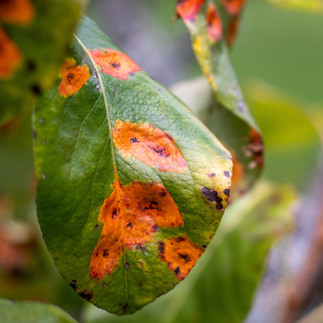How to identify and treat tree diseases
- Kerri Cuthbert
- Jan 15, 2024
- 2 min read
Trees, much like living beings, can be susceptible to diseases. Understanding that trees are living organisms and being able to recognise these diseases is essential for effective treatment and maintenance. In this blog, we'll explore various types of tree diseases you may encounter and provide practical guidance on how to treat them, ensuring the well-being and resilience of these natural inhabitants in your ecosystem and gardens.
Identifying Tree Diseases:
1. Powdery Mildew:
Appearance: White or grey powdery growth on leaves, stems, and sometimes flowers.
Impact: Generally mild, but can lead to leaf distortion and premature leaf drop.
Management: Improve air circulation, prune affected areas, and consider fungicide treatments if needed.
2. Leaf Rust:
Appearance: Yellow, orange, or red spots on leaves.
Impact: Affects plant vigour, but rarely fatal.
Management: Remove and destroy affected leaves, avoid overhead watering, and use appropriate fungicides.
3. Root Rot:
Appearance: Discoloured or soft roots, often accompanied by a foul smell.
Impact: It can be lethal as it affects the tree’s ability to absorb nutrients and water.
Management: Ensure proper drainage, avoid overwatering, and consider removing the tree in severe cases.
4. Canker Diseases:
Appearance: Sunken, dead areas on branches or trunks.
Impact: This can lead to structural weakness and branch dieback.
Management: Prune out infected branches, improve tree health, and avoid wounding the tree.
5. Verticillium Wilt:
Appearance: Yellowing and wilting of leaves, often on one side of the tree.
Impact: It can be fatal, especially in young or weakened trees.
Management: Remove affected limbs and provide adequate water and nutrients; sometimes, removal is the only option.n
Identifying Tree Diseases:
Look for unusual changes in leaf colour, texture, or growth patterns.
Inspect the trunk and branches for signs of damage or decay.
Note any fungi or mould growth, indicating internal decay.
Check for loose bark, a sign of underlying issues.
When to Consider Tree Removal:
Severe Structural Damage: If the tree’s structure is compromised, posing a safety hazard.
Irreversible Health Decline: Saving the tree is unlikely when a disease has progressed too far.
Spread of Disease: To prevent spreading to other healthy trees or plants.
Location Hazards: If the tree’s location poses a risk to property or people.
Seeking Professional Advice:
Consult a certified arborist for an accurate diagnosis and treatment options.
Arborists can also advise whether a tree should be removed.
Early identification and treatment can save many trees from removal. However, when removal is necessary, it's crucial to do so safely and professionally. Healthy trees not only enhance our landscapes but also support a diverse ecosystem.

Product Title
16 px collapsible text is perfect for longer content like paragraphs and descriptions. It’s a great way to give people more information while keeping your layout clean. Link your text to anything, including an external website or a different page. You can set your text box to expand and collapse when people click, so they can read more or less info.
$320

Product Title
16 px collapsible text is perfect for longer content like paragraphs and descriptions. It’s a great way to give people more information while keeping your layout clean. Link your text to anything, including an external website or a different page. You can set your text box to expand and collapse when people click, so they can read more or less info.
$900

Product Title
16 px collapsible text is perfect for longer content like paragraphs and descriptions. It’s a great way to give people more information while keeping your layout clean. Link your text to anything, including an external website or a different page. You can set your text box to expand and collapse when people click, so they can read more or less info.
$560





































I found the tips on identifying and treating tree diseases really insightful. It's fascinating how we can take preventative steps to ensure the health of our trees. Similarly, when it comes to drug addiction, early intervention is key. Just like diagnosing tree diseases early can prevent further harm, recognizing the signs of drug addiction and seeking the right treatment can lead to a healthier future. If you or someone you know is struggling with addiction, the Canadian Centre for Addictions provides expert resources and support to guide the recovery process, offering hope for a better tomorrow.